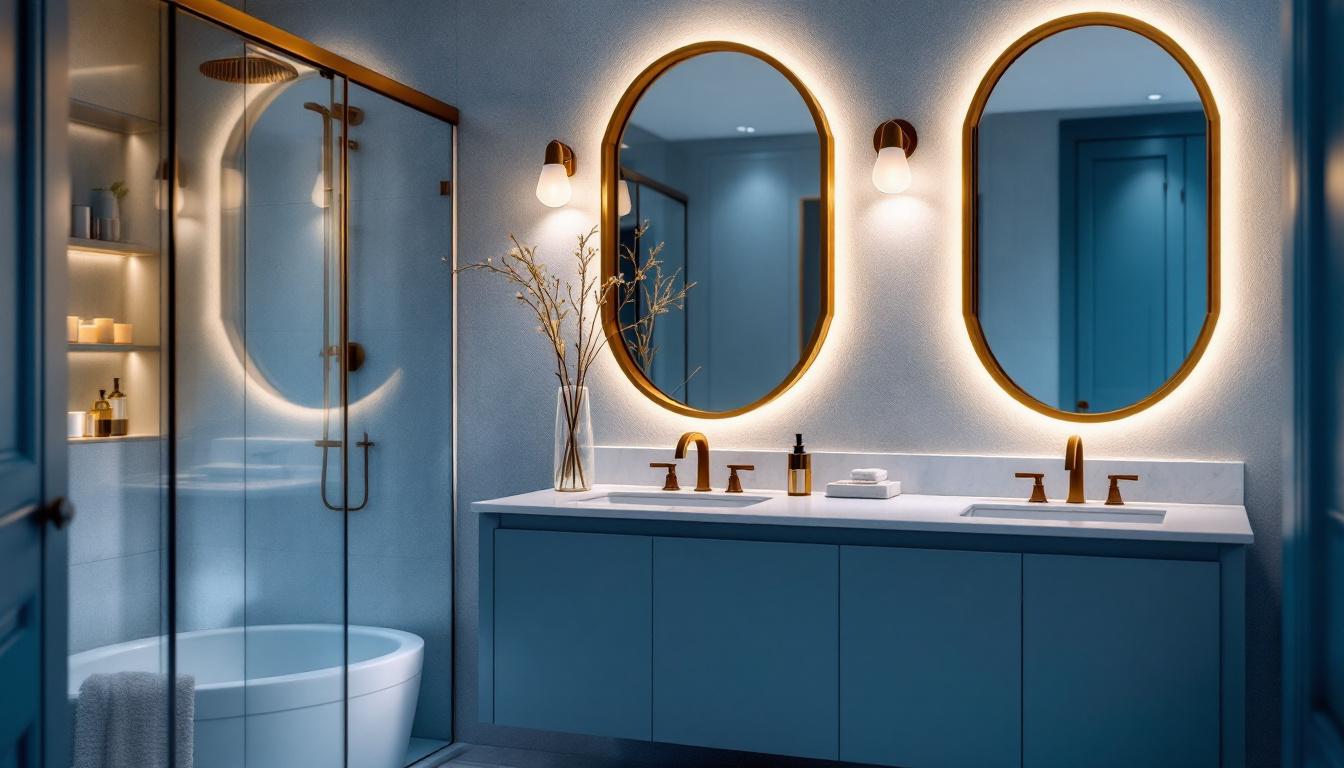
One of the most frequent errors lighting contractors make when installing bathroom vanity side lights is neglecting the precise placement of the fixtures. Vanity lighting isn’t just about illumination; it’s about creating balanced, shadow-free light that enhances facial features for grooming tasks like shaving, makeup application, and skincare.
Side lights should be installed at eye level, typically around 60 to 66 inches from the floor, flanking the mirror evenly on both sides. When fixtures are placed too high, low, or unevenly, shadows cast on the face can distort perception and reduce functionality. This is a common oversight that can turn a well-designed bathroom into a frustrating space for users.
Contractors must resist the temptation to place vanity lights arbitrarily or simply follow existing wiring locations without considering the end-user’s experience. Taking time to measure and plan the height and spacing of side lights ensures the light hits the face evenly, eliminating unflattering shadows.
Moreover, the type of bulbs used in these fixtures can significantly affect the quality of light produced. Opting for LED bulbs with a high Color Rendering Index (CRI) can provide a more natural light, which is essential for accurately assessing colors during makeup application or skincare routines. A CRI of 90 or above is ideal, as it allows colors to appear true to life, making it easier to achieve the desired look without the risk of over or under-applying products. Additionally, dimmable options can offer flexibility, allowing users to adjust the brightness according to their needs, whether they are preparing for a day at work or a night out.
Another critical aspect to consider is the overall design and aesthetics of the bathroom. The style of the side lights should complement the vanity and the overall decor. For instance, sleek, modern fixtures may work well in a contemporary bathroom, while vintage-inspired lights can enhance a more traditional space. This attention to detail not only improves functionality but also contributes to the overall ambiance of the room, creating a cohesive and inviting atmosphere that makes daily grooming a more enjoyable experience.
The choice of bulb and color temperature is critical in bathroom vanity lighting. Many contractors default to standard incandescent or overly bright LED bulbs without considering how the light quality affects the bathroom’s ambiance and functionality.
Warm white bulbs (around 2700K to 3000K) tend to create a cozy atmosphere but can distort skin tones. On the other hand, cool white bulbs (above 4000K) offer brightness but can feel harsh and clinical. The sweet spot for bathroom vanity lighting is usually a neutral white, around 3000K to 3500K, which balances warmth and clarity, rendering skin tones naturally and making grooming easier.
Another common mistake is installing bulbs with a high Color Rendering Index (CRI) below 80. A CRI of 90 or above is preferable for vanity lighting because it accurately reveals colors, which is essential for makeup application and shaving. Contractors should prioritize bulbs with high CRI ratings to deliver true-to-life illumination.
Furthermore, the placement of the bulbs plays a significant role in how light interacts with the space. For instance, wall-mounted fixtures on either side of the mirror can help eliminate shadows on the face, providing a more even distribution of light. This is particularly important for tasks that require precision, such as applying makeup or grooming facial hair. Additionally, dimmable options can enhance versatility, allowing users to adjust the brightness according to their needs, whether they’re enjoying a relaxing bath or preparing for a night out.
It’s also worth considering the overall design and aesthetic of the bathroom when selecting lighting. The style of the fixtures should complement the decor, whether it be modern, vintage, or somewhere in between. Bulbs that offer a warm glow can soften the look of stark tiles or cold fixtures, while sleek, contemporary designs can enhance a minimalist space. By thoughtfully integrating both function and style, homeowners can create a bathroom vanity that is not only practical but also visually appealing, elevating the entire experience of the space.
Bathroom lighting needs vary throughout the day and for different tasks. Yet, many contractors overlook installing dimmable fixtures or compatible lighting controls for vanity side lights. This oversight limits the bathroom’s versatility and user comfort.
Dimmable vanity lights allow users to adjust brightness levels, creating a soft glow for relaxing baths or bright, focused light for detailed grooming. Installing fixtures that are not dimmable or pairing them with incompatible dimmer switches frustrates users and reduces the overall value of the lighting installation.
In addition, integrating smart lighting controls or multi-level dimmers can elevate the bathroom experience. Lighting contractors should recommend and install systems that offer flexibility, ensuring clients can tailor lighting to their preferences easily.
Furthermore, the benefits of dimmable lighting extend beyond mere aesthetics; they also contribute to energy efficiency. By using lower light levels during times of relaxation, homeowners can reduce their energy consumption significantly, which is not only environmentally friendly but also cost-effective in the long run. Additionally, modern LED technology allows for dimming capabilities without sacrificing energy efficiency, making it a win-win for both functionality and sustainability.
Moreover, the psychological impact of lighting should not be underestimated. The right lighting can influence mood and well-being, transforming a mundane bathroom into a serene sanctuary. For instance, softer lighting can create a calming atmosphere ideal for unwinding after a long day, while brighter settings can invigorate the space, making it perfect for morning routines. By thoughtfully considering dimmability and lighting controls, contractors can help create a bathroom that caters to the emotional and practical needs of its users, enhancing their overall experience within the space.
Vanity side lights should complement the vanity’s size and style. Contractors often make the mistake of selecting fixtures that are too small, too large, or stylistically mismatched with the bathroom’s design, undermining both aesthetics and functionality.
For narrow vanities, slim and sleek side lights work best, while wider vanities may require larger or multiple fixtures to provide adequate illumination. The fixture’s finish and design should harmonize with the bathroom’s overall décor, whether modern, traditional, or transitional.
Ignoring these considerations can result in lighting that looks out of place or fails to provide sufficient light coverage. Contractors should consult with designers or clients to ensure fixture selection enhances the space visually and functionally.
Bathroom environments are inherently wet and humid, making electrical safety paramount. A common yet critical mistake is neglecting to use fixtures rated for damp or wet locations or failing to follow local electrical codes rigorously.
Vanity side lights must be UL-listed or certified for bathroom use to prevent hazards like electrical shorts or corrosion. Additionally, wiring should be installed with moisture-resistant materials, and GFCI (Ground Fault Circuit Interrupter) protection is mandatory in most jurisdictions for bathroom circuits.
Contractors must stay updated on the latest electrical codes and standards to ensure installations are safe and compliant. Cutting corners or overlooking these requirements not only risks client safety but can lead to costly rework and liability issues.
Relying solely on vanity side lights without considering the bathroom’s overall lighting scheme is a frequent misstep. Bathroom lighting should be layered, combining ambient, task, and accent lighting to create a balanced and functional environment.
Vanity side lights provide essential task lighting, but without adequate ambient lighting, the space can feel dim or unevenly lit. Overhead ceiling lights, recessed fixtures, or wall sconces can complement side lights, reducing shadows and enhancing the room’s atmosphere.
Lighting contractors should assess the entire bathroom layout and recommend a comprehensive lighting plan. This approach prevents over-reliance on vanity side lights and delivers a more comfortable, visually appealing bathroom.
Sometimes the biggest mistake isn’t technical but communicative. Contractors may install vanity side lights without fully understanding the client’s habits, preferences, or specific needs.
For example, a client who applies makeup daily may require bright, high-CRI lighting, while another who uses the bathroom mainly for quick grooming might prefer softer illumination. Without this insight, contractors risk installing lighting that doesn’t meet expectations.
Effective communication includes discussing fixture styles, bulb types, placement, and control options. Contractors should ask targeted questions and offer professional recommendations, ensuring the final installation aligns with the client’s lifestyle and enhances satisfaction.
Bathroom vanity side lights require periodic maintenance, such as bulb replacement and cleaning. Contractors sometimes overlook the importance of installing fixtures that are easy to access and maintain.
Fixtures mounted too high or in awkward positions can make bulb changes difficult and discourage upkeep, leading to dim or uneven lighting over time. Additionally, choosing bulbs with a long lifespan, such as LEDs, reduces maintenance frequency.
Contractors should prioritize user-friendly designs and educate clients on maintenance best practices. This foresight prolongs the lighting’s effectiveness and keeps the bathroom looking its best.
Bathroom vanity side lighting is deceptively complex. Proper placement, bulb selection, dimmability, fixture style, safety compliance, layered lighting, client communication, and maintenance all play vital roles in a successful installation.
Contractors who address these factors thoughtfully deliver lighting solutions that enhance functionality, safety, and aesthetics. Avoiding these common mistakes not only improves client satisfaction but also reinforces a contractor’s reputation for professionalism and expertise in bathroom lighting.
Ready to avoid these common pitfalls and elevate your bathroom vanity lighting installations? At LumenWholesale, we provide lighting contractors with the highest quality, spec-grade lighting products at the most competitive wholesale prices. Our extensive selection is designed to meet the highest industry standards, ensuring that your projects shine with reliability and performance. Plus, with free shipping on bulk orders, you can stock up on superior lighting solutions without worrying about hidden fees or inflated costs. Make the smart choice for your lighting needs and experience the best value in wholesale lighting with LumenWholesale today.

Discover expert tips and innovative solutions for installing LED lighting in drop ceilings.

Discover innovative strategies to future-proof your streetlight projects in this insightful guide.

Discover the top strategies lighting contractors use to maximize the benefits of 3500K LED bulbs.

Discover essential tips for lighting contractors on avoiding common pitfalls when installing weatherproof electrical box covers.